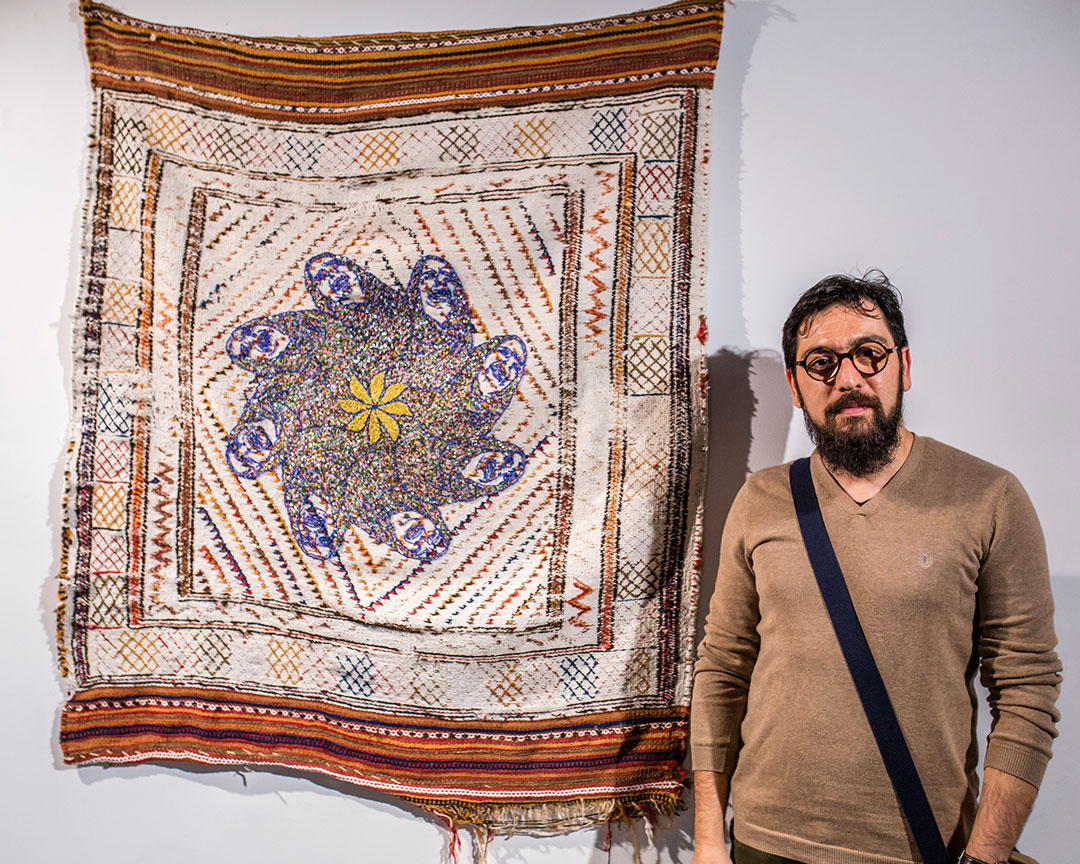By Arlo Langham
In November, entries will open for the second Footscray Art Prize. The Footscray Art Prize is a biennial event that rewards local and national artists, whilst seeking to contribute to Footscray’s reputation as one of Melbourne’s booming artistic and cultural areas. The inaugural 2017 Prize fielded over 800 entrants, exhibited over 60 unique works in several locations and awarded $17,500 in prize money across four categories.
In other words, it was a huge success.
The Tertiary Prize category is open to anybody enrolled at an Australian university or art college. Victoria University is a major partner in the event, and shortlisted entries are exhibited at VU at MetroWest, a community and arts space in the heart of Footscray.

Images courtesy of Victoria University. Photographer: Shuttermain
In 2017, the Tertiary Prize was awarded to Mohsen Meysami. His winning piece – ‘Their pain, our gain!’ – features a kaleidoscope of beads and thread on a found Persian Kilim. A work of sublime detail, ‘Their pain, our gain!’ demands of its audience an open mind and eye – Meysami wants to say things that are, “Often neglected in discussion … things we don’t see, or don’t want to see”. Meysami is a didactic artist, and while he does not think of himself as a teacher, a connection to his audience is vital. The mediums through which he builds this connection vary from piece to piece. Traditional textiles were the medium he turned to when highlighting his Identity as an Iranian artist living in Australia: “I started with my idea to paint over a Persian Kilim and the experiment continued with embroidery, beadwork and thread installation works.”
Meysami first studied graphic design in his native Tehran, attaining an M.A. from AZAD University of Art and Architecture in 2011, and is currently undertaking a PhD at RMIT, studying fine arts. When asked about the differences between studying arts in Tehran and Melbourne, he first denotes the differences between institutions and areas of study: “I think graphic design and fine arts are different courses regardless of the university or the country you study them in … art colleges here are very focused on graduate employability, which in itself has advantages and disadvantages.”

FAP TerTiary Winner Mohsen Meysami. Images courtesy of Victoria University. Photographer: Shuttermain
Preconceptions surrounding the dichotomy between art colleges and traditional universities don’t always hold true. Meysami is undertaking hands-on, practice-led research at RMIT, whereas his master’s degree at an arts college in Tehran, featured, “a combination of research and course-work”. This provided the opportunity to develop his theoretical knowledge and research skills. He believes that, at the end of the day, “there are different research methodologies for different types of research”. For his current research – exploring the ongoing conflict in the Middle East through traditional arts and craft – a qualitative approach simply works best.
Meysami doesn’t see much of an inter-university relationship when it comes to art in Melbourne. He says that while universities and other tertiary institutions can help artistic communities grow, it is important to find, “a balance between education and creativity”, and that creativity can be hindered when, “everyone is taught the same thing”. Initiatives such as the Footscray Art Prize help to maintain this balance, while also trying to foster a spirit of cross-institution creativity. In 2017, the Tertiary Prize fielded entries from students at nineteen different institutions, with shortlisted works in the category coming from three different states.

Images courtesy of Victoria University. Photographer: Shuttermain
Winning the Tertiary Prize in 2017 was very important for Meysami. “I remember at that time I was in two minds about the method and the materials I was working on … I needed to know if I made the right decision and if it was actually working!” Since winning the award, he has had his work exhibited in Australia, overseas in Venice and Hong Kong, and back home in Iran. In June he returned to the scene of his victory in the 2017 Footscray Art Prize, VU at MetroWest, for a solo exhibition: WELCOME-NOT WELCOME.
Meysami believes that the Footscray Art Prize, “Gives opportunities to artists to think about how their art is understood or interpreted once it leaves the studio … engagement with the art community, exposure and professional development are great opportunities for artists.”
Entries open for the 2019 Footscray Art Prize will open on Friday 23 November 2018.
See website for details: footscrayartprize.com
Arlo Langham is a creative and professional writer from Footscray. He is an alumnus of Victoria University, having completed a Bachelor of Creative Arts Industries (specialising in creative writing and digital media) in 2016, and a Bachelor of Creative Arts (Honours) in 2017, for which he produced a practice-led thesis on Australian working class fiction. He has had short fiction published in Offset Arts Journal and Hyde Magazine, as well as non-fiction pieces in The Westsider newspaper. Arlo works as part of the Footscray University Town initiative, a joint partnership between Victoria University and the City of Maribyrnong.
